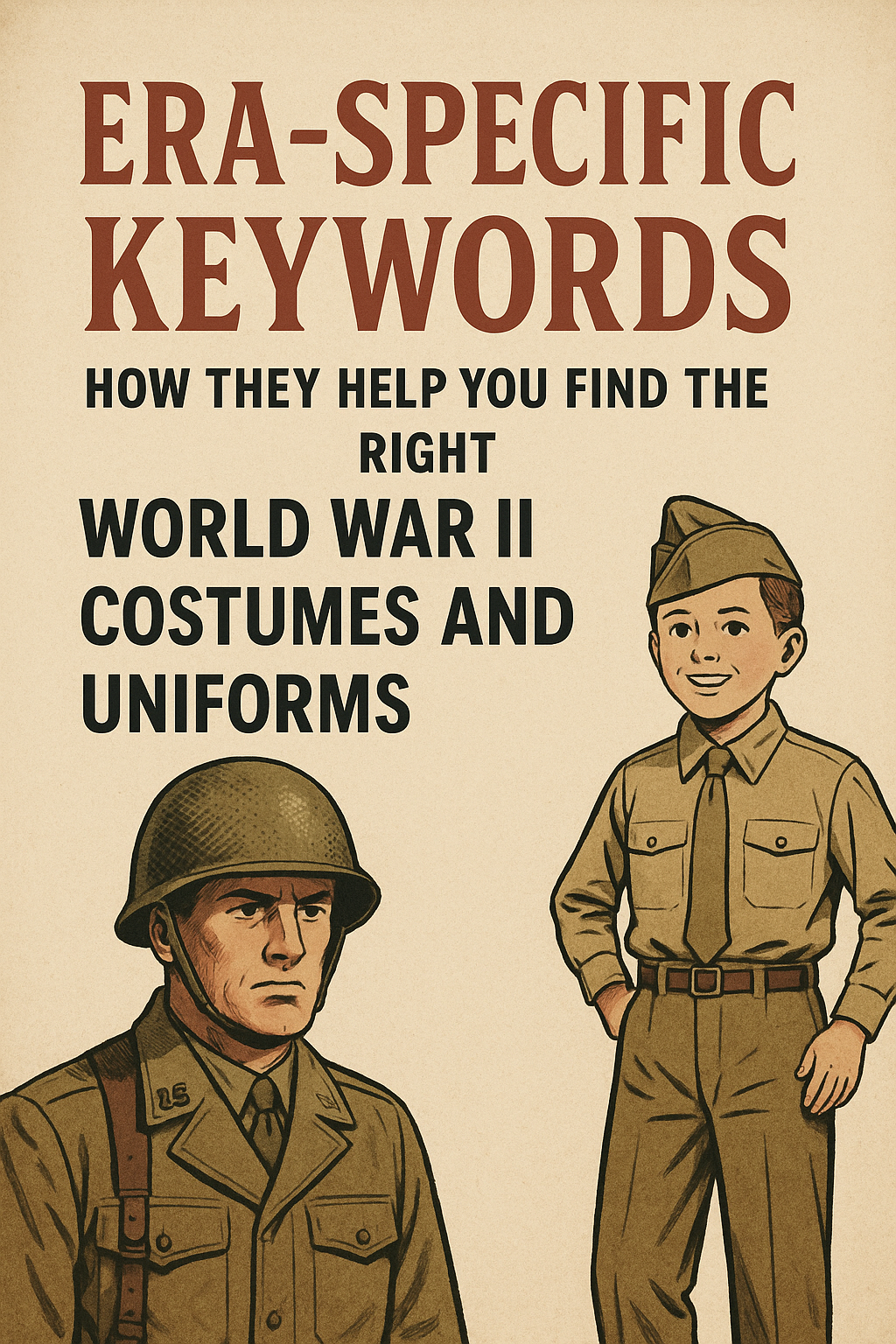
Era-Specific Keywords: How They Help You Find the Right World War II Costumes and Uniforms
Published on May 14, 2025
Introduction: Understanding the Role of Era-Specific Keywords
In the world of historical reenactments and vintage collectables, accuracy matters—and that accuracy often begins with the words you type into a search bar. This is especially true when shopping for World War II American uniforms, WW2 children's costumes, or looking to sell military uniforms from that era.
Whether you're preparing for a school history day, a theatrical performance, or a military reenactment, using era-specific keywords ensures you find clothing and gear that match the period you’re interested in.
This article explains how era-specific keywords help direct shoppers to the most relevant, authentic, and historically accurate World War II costumes, with a focus on both adult and children's options.
What Are Era-Specific Keywords and Why Are They Important?
Era-specific keywords are terms directly tied to a historical period, such as:
- World War II
- WW2 uniforms
- 1940s military outfit
- World War 2 costumes boy
- WWII American uniforms
Unlike generic search phrases like “army costume” or “military gear,” these keywords connect search engines and buyers to products that are accurate to the period, improving both the relevance of the search and the quality of the results.
They also help businesses like ours structure product descriptions, blogs, and category pages to reach those actively looking for historically inspired apparel.
Targeting Historical Accuracy in Search
When customers use terms like “World War II American uniforms” or “WW2 children's costumes,” they are typically searching for products that offer:
- Genuine historical design
- Correct insignia, patterns, and colour schemes
- Proper military ranks or roles
- Educational or collectable value
Using accurate, time-specific language in your search increases the likelihood of discovering authentic or museum-grade replicas. For children’s costumes, for example, this might mean finding a detailed boy’s WWII soldier uniform rather than a generic green jumpsuit.
Common Era-Specific Keywords That Convert
Below is a short list of effective era-specific keywords and their relevance in customer searches:
KeywordUse Case
World War II American uniforms For adult reenactors, collectors
WW2 children’s costumes For school events, history plays
World War 2 costumes boys Specific to gender and age group
WWII uniforms for sale Appeals to buyers and collectors
Sell military uniforms For sellers and resellers
Authentic WW2 uniform Indicates historical accuracy
These keywords signal both intent and interest in high-quality, historically correct products.
WW2 Costumes for Boys: Historical Value in Education and Play
Dressing up as a WWII soldier isn’t just fun—it’s educational. Parents and teachers increasingly look for historically grounded outfits when shopping for a World War 2 costume for a boy. These costumes help kids connect with history in a hands-on way, whether through school projects, museum visits, or dramatic performances.
Important features include:
- Accurate patches and badges
- Correct military cuts and shades (like olive drab or khaki)
- Comfortable materials suitable for all-day wear
- Accessories like hats, belts, and toy medals for realism
By using the right keywords in your search, you’re more likely to come across these authentic options rather than costume-store approximations.
Selling Military Uniforms: How Keywords Affect Value and Reach
If you’re a collector or someone looking to sell military uniforms, era-specific keywords are just as important. Proper labelling ensures that your items are found by the right buyers—those who understand and appreciate their historical worth.
Use detailed, era-based terms like:
- “WWII paratrooper uniform”
- “1940s US Navy jacket”
- “Authentic World War II army shirt”
Adding information like the year, country, and military branch can also help your item show up in filtered searches and attract higher-value buyers.
Why We Focus on Era Accuracy in Our Costume Collections
As a brand dedicated to preserving and presenting military history through clothing, our collection is built around accuracy and respect for the period. Whether you’re looking for:
- Complete WWII American uniforms
- Miniature reenactment outfits for kids
- Collectible or resale military pieces
We ensure each product is tagged and described using the most relevant and specific historical terms. This makes our site easier to search, and our customers are happier with what they find.
Our attention to detail includes:
- Research-backed uniform designs
- Realistic stitching, badges, and insignia
- Age-appropriate materials for children
- A balance between affordability and historical integrity
Tips for Using Era-Specific Keywords in Searches
If you’re browsing for historical military costumes or uniforms, here are five quick tips:
- Always include the era (e.g., “WW2” or “1940s”) in your search.
- Be specific about the item—search for “WWII infantry jacket” instead of “military jacket.”
- Mention the country (e.g., “American,” “British,” “German”) to filter results.
- Use child-focused keywords like “WW2 children’s costume” for youth attire.
- Add the word “authentic” or “replica” if accuracy is important to you.
These small changes can dramatically improve what shows up in your results—and help you avoid wasting time on irrelevant items.
Conclusion: The Power of Historical Precision
Era-specific keywords are more than just SEO terms—they’re tools for preserving history, improving your search accuracy, and ensuring that what you buy or sell aligns with the real legacy of the time.
Whether you're a reenactor searching for World War II American uniforms, a parent looking for World War 2 costumes for boys, or a collector aiming to sell military uniforms, precise language leads you to better results.
At Paddelaters, our mission is to bring history to life through detailed, period-accurate costumes and uniforms. Every product we offer is a tribute to those who wore them—and every keyword we use helps you find the story you’re looking to wear.
